I must have been living under a rock, or out of the country or just covered up with stuff because I didn’t know anything about this upcoming game from Draco Ideas in the War Storm Series called Help Arrives!. Plus it is designed by Nicolás Eskubi. Help Arrives! is a tactical hex & counter wargame, the fifth in the War Storm Series, and deals with the Spanish Civil War. It is a big game with over 800+ counters, has amazing art, lots of scenarios and a campaign to play and much more! We reached out to Nicolás for an interview and he was very quick to answer our call.
If you are interested in Help Arrives! you can back a copy on the Kickstarter page at the following link: https://www.kickstarter.com/projects/dracoideas/help-arrives-spanish-civil-war?ref=3zyzd2
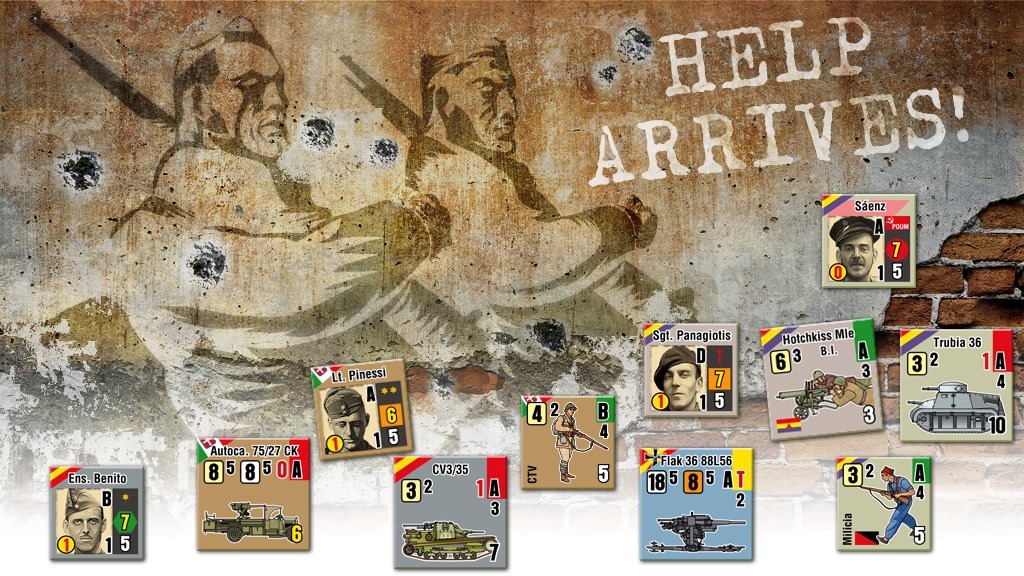
Grant: What is your new game on Kickstarter called Help Arrives! about?
Nicolás: It’s a game that places us in the Spanish Civil War and in which you can command both sides with their different factions, including the Nationalist faction and Republican faction.
Grant: What is important from the Spanish Civil War to make sure and model in the game?
Nicolás: The great differences between both sides and in particular, in the different units of each faction. There also were very clear differences in training, weapons, morale, etc. These differences make both sides a totally different experience to play and requires you to think about how best to use the assets you have.
Grant: How similar is the design to A las Barricadas!?
Nicolás: Considering that Help Arrives! is an evolution of A las Barricadas! the similarities between the designs is remarkable although there are changes and upgrades and definite differences.
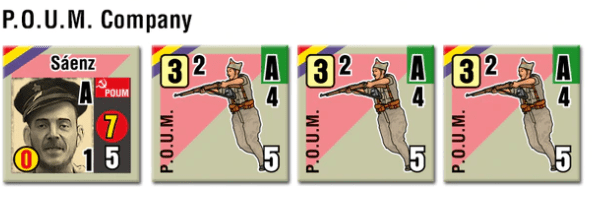
Grant: How does Help Arrives! fit into the timeline in relation to A las Barricadas! and the Spanish Civil War?
Nicolás: They both share the same timeline, the biggest difference between the two is that Help Arrives! includes units of international aid received by both sides, not counting the before mentioned aspect regarding the rules and how they share the same system.
Grant: What does the name mean from the history?
Nicolás: I wanted to emphasize that although it is still a game about the Spanish Civil War, it reflects the international aid received by the Army of the Republic (Government) and the National Army (Rebel). Help arrived for both sides in the form of troops, weapons, gear and money.
Grant: What were your major challenges with the design?
Nicolás: Trying to make sure to reflect the great differences between both sides and also to be as faithful as possible to the story reflecting these differences but at the same time, by applying these changes keeping the game playable and making sure that it was an enjoyable experience.
It was also challenging to apply an established series of rules to account for new factors to officers and certain units with new rules but without complicating the regulations, all this in a simple and very intuitive way. This was not as easy as I had thought it would be but was a good exercise.
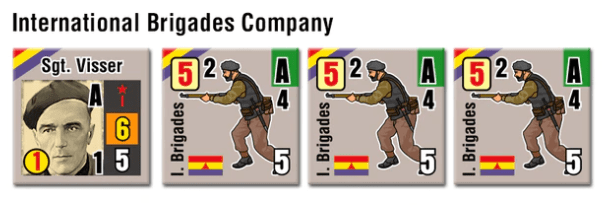
Grant: As you alluded to, the game uses the standard rules for the War Storm Series. What specific new rules did you add and why were these rules needed?
Nicolás: Help Arrives! is based on the standard v2.1 rules but with the logical changes to cover the Spanish Civil War with the notable differences in technology and tactics between this conflict and World War II. In itself, this version already has a series of changes and updates to existing rules and some new ones that have been improved to fit into the existing rules. It has not really been necessary to add many new rules but only to highlight and better clarify a couple that substantiate the current ones. These new rules include Armored unit tactical and operational movement and Counter Battery rules; this as for the standard v2.1 focused on World War II.
Regarding the standard v2.1 rules of the Spanish Civil War, new rules have been added for officers and troops in which a further step is taken in differentiating the training of these commands as well as the training of the troops to their command, reflecting the uneven formation of the commanders as well as the handling of weapons by the units.

Grant: What is the scale of the game and how did you focus on this during the design to get it right?
Nicolás: The scale of the game is platoon level, representing each hexagon between 150m to 200m, each turn represents approximately 12 minutes. It was clear to me that I wanted to represent platoons forming companies and based on the selected scale and with the documentation used for the details, I think a good job was done reflecting the use of this type of units to this detail, being as faithful to history but without overcomplicating the rules of the game.
Grant: Does this game use the “WE GO” system used in Normandy: The Beginning of the End? What is this system for those that don’t know?
Nicolás: The saga (War Storm Series) is based in the principle of the simultaneous execution referred to as “WE GO”. The turns are separated into distinct phases including Command Phase, Initiative Phase, Activation Phase and Performing Actions and Marker Removal Phase. Each player takes turns during the execution of the phases but while you execute them, the opponent can react to your actions, making the game very dynamic and simulating a real-time game. This difference between this system and traditional I-GO-U-GO really boils down to dynamic action. No action is ever taken with out a chance from your opponent to react if they so choose.
Grant: Why was it appropriate for this game?
Nicolás: I’ve been a Combat Mission player since they published their first game, a series of games that use the “WE GO” system and by scale and system I thought it was the best possible system for the War Storm Series. Avoiding long waits and downtime while your opponent makes their movements, etc. making the game much more agile, interactive and fun.

Grant: Do Officers still play a significant role in the design? How can lack of officers negatively effect troops?
Nicolás: Of course it’s the backbone of the game. In the War Storm Series a bad officer can make things much more difficult for you and he can do it in different ways, due to his low morale, his ability to coordinate or his command rank. This is especially true in Help Arrives! as the new abilities provide that a good commander can help his men avoid suffering many casualties and a bad commander will cause more such casualties.
Grant: How important is troop morale to this design? How did you model it for this type of fighting?
Nicolás: Morale, as it cannot be otherwise, is very important just as it does in real world military units. A unit with high morale will be able to perform a series of actions with a high percentage chance of success, unlike a unit with low morale that is still unable to even attempt the same action.
Platoon and company morale represents the mental stamina and cohesion of the soldiers that belong to them. The higher the morale, the better chance they have of staying in combat after suffering step losses, losing an assault, or encountering any other negative effect.
WSS features two different types of morale: whole company morale and individual platoon morale. This is needed because during the game several circumstances may trigger a procedure called morale check, which is used to determine whether the unit is completely operative and under control to perform an action. This procedure may affect the whole company or just a single platoon.
Grant: Why do you feel the use of isomorphic maps give the design an advantage over traditional set maps?
Nicolás: Because of the ease it provides when designing scenarios and campaigns, offering a much greater replay value considering that WSS games provide points lists and rules on how to design your own scenarios, offering users very useful tools. The best part is that each game in the series only uses isomorphic maps, and if you have other games in the series, you can even use them and create a variety of impressive and unique scenarios.
Grant: Can you show us a few examples of the maps?
Nicolás: Of course, here are 3 maps from Help Arrives!.
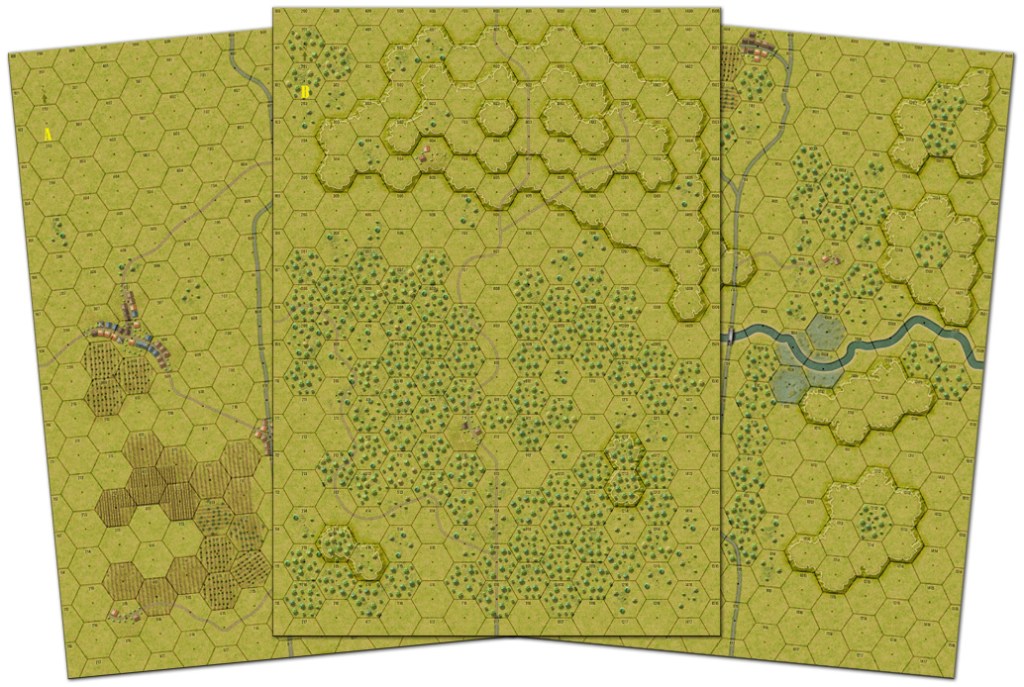
Grant: Your counters are always so great. What is the anatomy of the counters and the different information?
Nicolás: Thanks for your kind words!. In this case I think a picture is worth a thousand words.
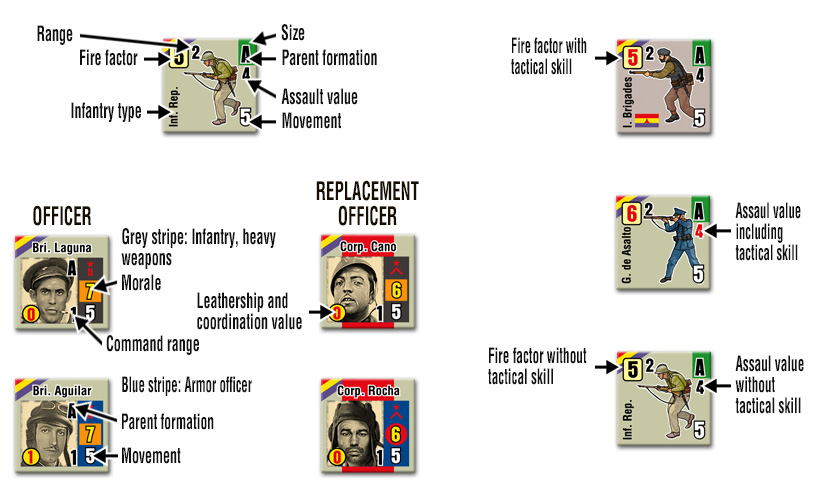
Grant: Can you show us some examples of the different sides units?
Nicolás: Sure! This example does not include all types of weapons and platoons, they are only a reference of the factions.
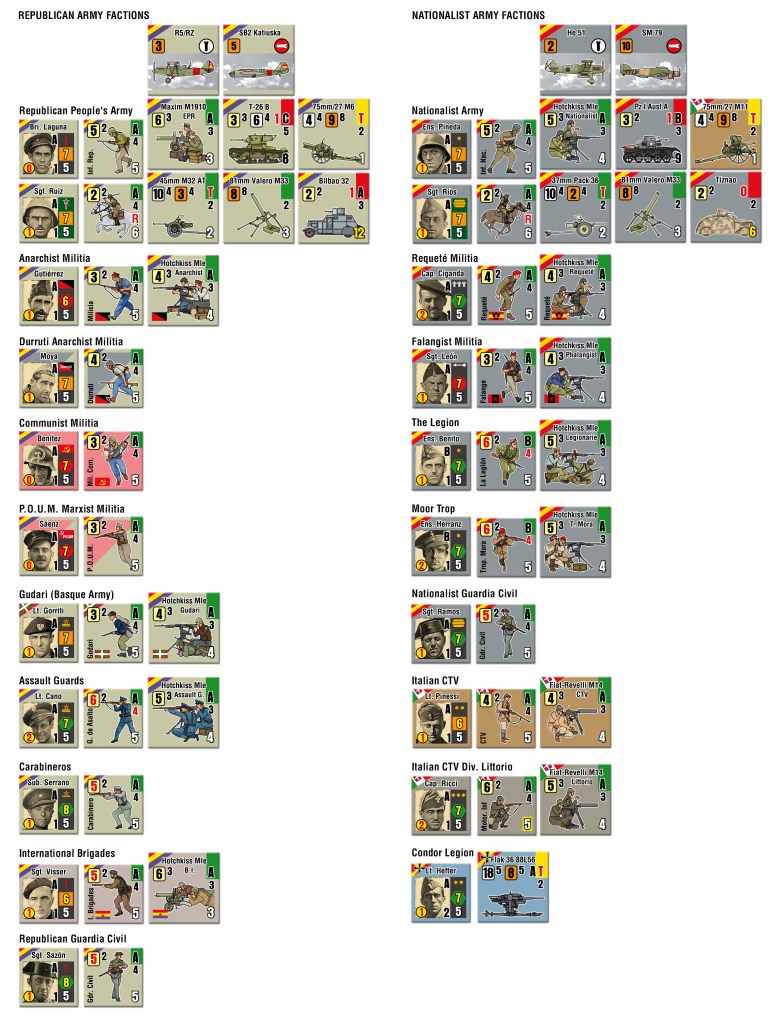
Grant: What scenarios are available?
Nicolás: Help Arrives! includes 13 scenarios of which many of them are part of different campaigns although they can be played in two ways, separately or by playing the campaign. The 3 campaigns are: “Battle for Madrid”, “Battle of Jarama” and “The Ebro”.
Grant: Are there special scenarios planned as stretch goals?
Nicolás: Yes, we have many surprises for the patrons, which we will reveal during the campaign,
Grant: Will this design include the Alone in the Storm solo system? How did it get modified for Help Arrives!?
Nicolás: Alone in the Storm is an independent module that comes in its own box. What includes Help Arrives! are the tables that collect the new units for the mission generator for Alone in the Storm.

Grant: What do you believe the solo system does well?
Nicolás: It is a great solitary module with a really competent AI that is difficult to defeat but this module also offers the possibility, apart from playing alone, the possibility of playing in cooperative mode for 2 to 4 players and contains a scenario generator.
Grant: Can this Alone in the Storm system be used with all War Storm Series games?
Nicolás: Correct, that was the initial idea when designing this module, that it would be possible to use it with the games currently published and with future games to come.
Grant: What are you most pleased about the new title Help Arrives!?
Nicolás: The main one is the conflict in particular, the Spanish Civil War fascinates me. Then it is a war that is halfway between WWI and WW II with the difference in weapons and the tactics used making the scenarios more complex, perhaps in which you have to be very clear about the tactics to follow due to the composition of the troops you have under your command and with the material you have available to carry out the entrusted mission resulting in very close matches, in which you enjoy and suffer in equal parts. A real challenge!
Grant: What type of different experience will it offer players who are familiar with the system?
Nicolás: As I have commented previously, it will be a different experience than the previous title, Normandy: The Beginning of the End, this time the technology and weapons at your disposal are totally different, you will have to be more cautious when planning, use a lot more rounds, make more use of coordination, survive more bloody fights, a challenge.
Grant: When do you expect the game to be fulfilled?
Nicolás: The approximate delivery will be May 2021, although we hope that it will be earlier, but due to the pandemic, outbreaks and unforeseen events, we have preferred to delay the possible delivery date.
Thanks for your time in answering our questions about the game Nicolás. The game looks amazing, not only in its aesthetic components, but the game play looks interesting and I am excited to see how it plays.
If you are interested in Help Arrives! you can back a copy on the Kickstarter page at the following link: https://www.kickstarter.com/projects/dracoideas/help-arrives-spanish-civil-war?ref=3zyzd2
-Grant
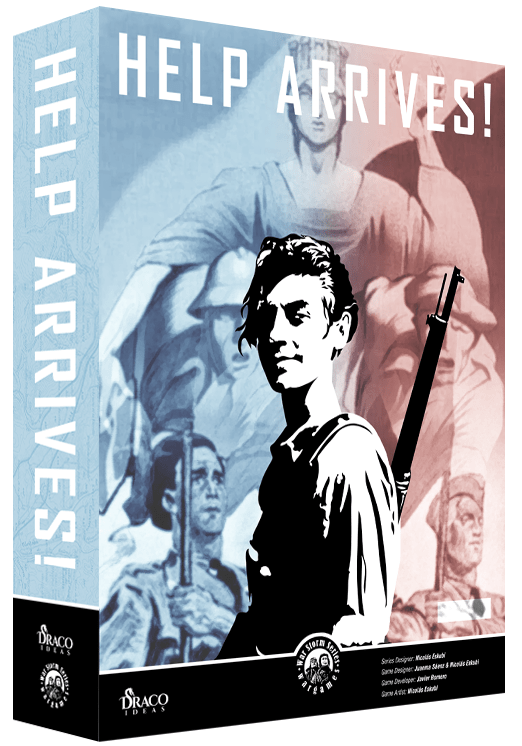
Grant!
THANK YOU for this interview. I am a MASSIVE fanboy of TSCW, and own many games for LAS BARRICADES, to SHOCK ARMY, Teruel, and a handful of others.
This conflict, in many ways, is unique… much like The Russian Civil War, The Mexican-American Civil War. It’s NOT like, say, C&C Ancients, Napoleonics, or many larger wars. Soldiers ranged widely in terms of training, political agendas, and allies. The Republic of Spain, in 1934, was a country in extreme transition… when the Popular Front took over in 1936, political tensions were almost at a breaking point… regional, religious and political differences and vendettas swept the countries… and with such a polarized country, fighting an organized war with standardized training and equipment must have been a nightmare! THEN… enter Hitler, Il Duce and Stalin, experimenting with their new potential weapons and tactics… it was CHAOS.
THis game is PERFECT! I am a real fan of Las Barricades.
LikeLiked by 1 person
From a historical and military point of view can be considered fascinating but for the people and the families it was a tragedy. Spain was victim of its own demons but also victim of the ominous pairing between fascists and liberal capitalists.
LikeLiked by 1 person
Is there a video of the interview?
LikeLike
No. Written interview only.
LikeLike